 | ||
The Stearman XBT-17 was a prototype 1940s American two-seat low-wing monoplane primary trainer designed and built by Stearman Aircraft (as the Model X-90). It was evaluated by the United States Army Air Force in 1942 as the XBT-17.
Contents
Design and development
The X-90 was a low-wing cantilever monoplane with two-seats in tandem under an enclosed canopy. It had a fixed conventional landing gear and was powered by a 225 hp (168 kW) Lycoming R-680 engine and first flew in 1940. It had wooden wings and a steel tube forward fuselage in order minimize use of aluminum. In 1942 the aircraft was re-engined with a 450 hp (336 kW) Pratt & Whitney R-985 engine and redesignated the Model X-91. The X-91 was evaluated by the United States Army Air Force as the XBT-17 but no more were built.
Variants
Specifications (XBT-17)
Data from
General characteristics
Performance
